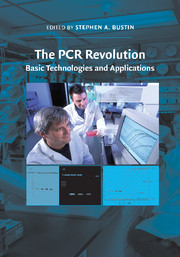Book contents
- Frontmatter
- Contents
- Contributors
- Foreword by Russell Higuchi
- Preface
- I BASIC TECHNOLOGIES
- 1 Real-time polymerase chain reaction
- 2 Thermostable enzymes used in polymerase chain reaction
- 3 Inventing molecular beacons
- 4 Rapid polymerase chain reaction and melting analysis
- 5 Polymerase chain reaction and fluorescence chemistries: deoxyribonucleic acid incarnate
- 6 Analysis of microribonucleic acid expression by quantitative real-time polymerase chain reaction
- 7 Miniaturized polymerase chain reaction for quantitative clinical diagnostics
- 8 The road from qualitative to quantitative assay: What is next?
- 9 Taking control of the polymerase chain reaction
- II APPLICATIONS
- Index
- Plate section
- References
5 - Polymerase chain reaction and fluorescence chemistries: deoxyribonucleic acid incarnate
Published online by Cambridge University Press: 25 January 2011
- Frontmatter
- Contents
- Contributors
- Foreword by Russell Higuchi
- Preface
- I BASIC TECHNOLOGIES
- 1 Real-time polymerase chain reaction
- 2 Thermostable enzymes used in polymerase chain reaction
- 3 Inventing molecular beacons
- 4 Rapid polymerase chain reaction and melting analysis
- 5 Polymerase chain reaction and fluorescence chemistries: deoxyribonucleic acid incarnate
- 6 Analysis of microribonucleic acid expression by quantitative real-time polymerase chain reaction
- 7 Miniaturized polymerase chain reaction for quantitative clinical diagnostics
- 8 The road from qualitative to quantitative assay: What is next?
- 9 Taking control of the polymerase chain reaction
- II APPLICATIONS
- Index
- Plate section
- References
Summary
ILLUMINATING THE UNSEEN
The polymerase chain reaction (PCR) is a revolutionary piece of chemistry that has upended the science of biology by allowing manipulation of individual molecules of deoxyribonucleic acid (DNA). With a broad reach into drug development, forensics, and the sequencing of the human genome, PCR has already touched persons who may never pick up a pipette. Relying upon awkward language like oligonucleotide and amplicon makes explanation of its mechanism a difficult lesson, but replicating any sequence of DNA is of fundamental importance to modern biotechnology.
And replicate it does. Not only does PCR succeed in finding the needle in the haystack, it proceeds to make an entire haystack out of needles! This unrelenting amplification of the DNA molecule evokes images of the Sorcerer's Apprentice, where the utility of a single broom is recognized and duplicated until it takes on a life of its own.
In certain laboratories, PCR can also wear out its welcome when the sorcery becomes hard to control. Replicating the very sequence that one intends to detect is both a blessing and a curse because residual molecules from previous experiments make it hard to start again with a clean slate. They can splash onto the laboratory bench, cling to gloves, and even launch into the air to leisurely float down onto an inconvenient location (inconvenient for the researcher, at least).
- Type
- Chapter
- Information
- The PCR RevolutionBasic Technologies and Applications, pp. 70 - 79Publisher: Cambridge University PressPrint publication year: 2009



